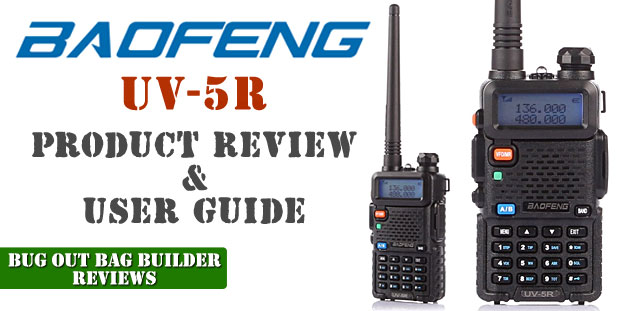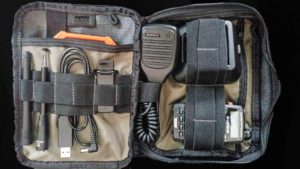
Communication during an emergency between yourself and your friends and family is so crucial that it almost goes without saying. Yet have you considered what you would do if the phone networks went down? What if there was no more internet? It doesn’t take a big stretch to imagine these possibilities.
And yet very few people have any real plan for backup communications. That’s almost crazy when you consider that for $30 you can get a device which will allow you to connect to your local community, hear severe weather alerts, get by-the-minute updates on what the emergency responders are doing, and if need be, even call for help.
Enter the Baofeng UV-5R the entry level radio everyone can afford and every family should have.
DO YOU NEED A Handheld BAOFENG UV-5R?
The radio snob in me wants to start off by saying that there are other radios out there – and many of them are a lot more reliable than the Baofeng UV-5R. Icom, Motorola, & Yaesu make excellent HT (Handy Talkie) radios. And you might be much better served by having a more substantially reliable radio like one of those. If I had to put my life on the line I would prefer to have a radio I know I can always count on to work when I need it to.
But since the majority of us will go for the cheapest thing available and since you’re usually looking at around $150 to get one of the better brands I decided to write this article to discuss the entry-level Baofeng so folks like yourself can understand what this radio can and can’t do. And since we now own 5 of them we shouldn’t talk too much smack about them now, should we ?
IMPORTANT NOTE
It should be said that in order to transmit with a UV-5R a License from the FCC is required, since you can only legally use Amateur Radio Services and GMRS with these types of radios. Of course that could all fly out the window in a SHTF scenario, so plan as you see fit.
WHAT ABOUT THE NON-LICENSE FREQUENCIES?
You don’t need a license to transmit on the FRS frequencies, which are the same frequencies the walkie-takies your kids have from Walmart transmit on. HOWEVER the UV5Rs transmit between 1 to 4 watts (its adjustable), and the legal limit for FRS is only 0.5 watts, so it is ILLEGAL to transmit on FRS with these radios except in a life or death emergency. FYI those frequencies are listed here.
They can transmit and receive on the 5 MURS frequencies, but since the UV-5R has the ability to transmit using more that 2 watts of power, it is also technically illegal to use them on MURS channels. You can dial the power below 2 watts and use MURS to comply with the rules of those frequencies, but do so at your own risk. MURS does allow you to use an external antenna so simplex transmit and receive ranges of 10 miles is not unobtainable although not the norm. I’ve found MURS to work pretty well up to about a mile or so on flat ground with the Baofengs. Another MURS option is to look into something like a goTenna.
AND THE LICENSED ONES?
For $90 (soon $65) you can get a 5-year license for you and your family to use GMRS which is legal to do with these radios. Here is a guide on how to do that. GMRS can use repeaters and up to 50 watts of power and external antennas. No test required! This is a very good option.
Last and most important, you can use the Amateur Radio Service aka Ham Radio. You will need to pass an exam to get your Technicians License. This is really the best option but requires a some time and commitment. There is only a $15 fee to take the exam, and if you pass the license is good for 10 years. We walk you through the process here.
YOU DON’T NEED A LICENSE TO RECEIVE TRANSMISSIONS.
And that is the true beauty of this radio for the average person, and why it’s a necessary tool and part of your bug out communications planning. It gives you a very powerful informational tool, one that’s portable, fairly uncomplicated to use, and cheap.
With a little bit of research you can find out what frequencies the ARES and RACES groups transmit on, and listen in. Those are volunteer emergency associations which assist first responders with boots on the ground information about conditions affecting their area. If you want to look for local “nets” in your area use this tool from the ARRL. It will show you the frequencies of the “repeaters” that the nets are taking place on.
There are a couple of good frequencies to program into your radio…
Continue reading article BAOFENG UV-5R REVIEW & GUIDE from www.bugoutbagbuilder.com
Related article: Ham Radio Go Bag



Great article, cleared up a lot of things for me about these radios. Thanks.
I have two of these. I made a j pole to use for longer distances. I do have a ham license as well. We have a community ham club as well for emergency response.
I’ve never really felt any need to get into HAM radio stuff until reading this. $30 is kind of a hard price to beat for a radio, and if I don’t really get too into it, well…it’s only $30.
And if the SHTF, it’s far too useful to dismiss.
Something to think about.
I have two of these inexpensive radios as well as an expensive Yaesu radio which I use almost daily (as a licensed ham). I programmed the Baofengs with FRS, GMRS, MURS, and various 2 meter ham simplex and repeater frequencies. Each radio is programmed the same. I store both radios in a galvanized trash can Faraday cage which cost me less than $20. The Faraday cage is lined with cardboard and the lid is sealed with aluminum tape. The radios are stored in metallic Faraday bags (thank you Amazon) for double protection as recommended by many experts in the field. I check the contents every 8 months or so to charge the batteries and add or remove electronics as I feel necessary. This may seem like a lot of work but communications will be essential if the grid ever goes down due to an EMP or CME.
The regulations I read said you can use the radio without a license to get help in an emergency where human life or property is in danger.